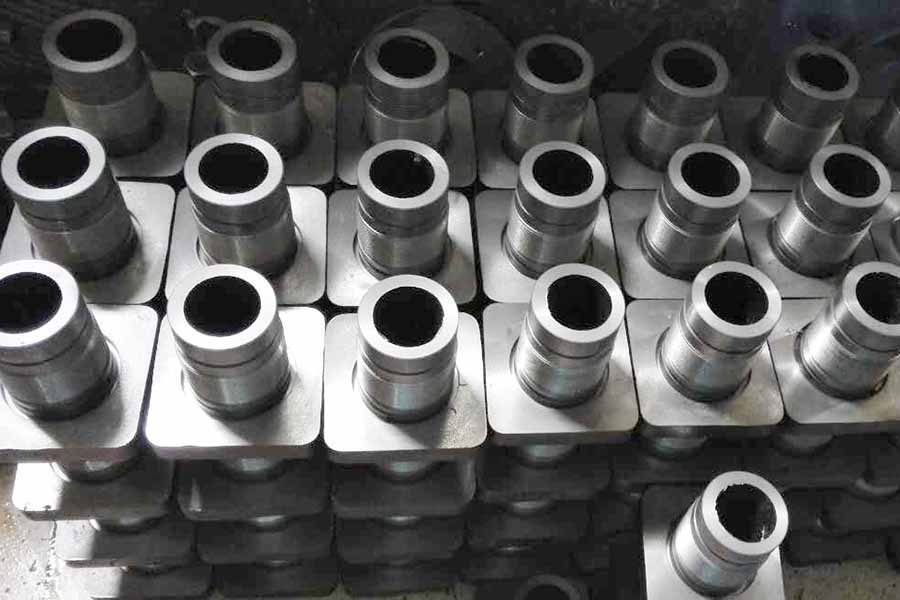The Si, Mn and other residual trace elements contained in the cast steel have an impact on the casting performance of the cast steel and the fluidity of the molten steel.
The relationship between casting performance and various elements in steel castings:
1) Chemical elements that improve fluidity: Si, P, Cu, Ni, Mn
2) Chemical elements that reduce fluidity: Ti, Cr, Al, S, V, Mo, W
3) Chemical elements that increase the tendency of shrinkage cavity: C, Cr, Mn, V, Mo, Ni
4) Chemical elements to reduce thermal cracking tendency: V, Mn, Al, Si
5) Chemical elements that increase the tendency of thermal cracking: S, Si, P, Cu, Mn, Cr, Mo, Ni

The influence of various chemical elements on the casting properties of cast steel.
1) Carbon
Carbon can improve the fluidity of cast steel2) Silicon
• Silicon can lower the melting point of cast steel and improve fluidity
• When the silicon content in cast steel is less than 0.4%, the hot cracking tendency of cast steel can be improved. When the content of silicon is high, columnar crystals are easily formed, increasing the tendency of thermal cracking
3) Manganese
• Manganese can reduce crystallization and improve the fluidity of cast steel
• Manganese will increase the volume shrinkage and linear shrinkage of steel castings, and increase the tendency of cold cracking and hot cracking
• Manganese element generates MnO in cast steel, which forms chemical sticky sand with silica in molding sand
4) Sulfur
Sulfur elements generate MnS and aluminum trisulfide in cast steel, reducing the fluidity of cast steel and increasing the tendency of hot cracking
5) Phosphorus
Phosphorus can improve fluidity, but increase cold cracking tendency and hot cracking tendency
6) Copper
• Copper can lower the melting point of cast steel, narrow the crystallization range, and improve the fluidity of cast steel
• When the copper content in cast steel is higher than 1%, the copper element is easy to precipitate freely, thereby increasing the tendency of hot cracking. Increasing the content of Si and Mn can increase the solubility of copper in cast steel.
7) Molybdenum
• In the low alloy range, molybdenum alloys can reduce the fluidity of cast steel
• Mo element will slightly increase the tendency of cast steel to shrink cavities
• When the molybdenum content in cast steel is less than 1%, MoS will be formed to precipitate on the grain boundary, thereby reducing the thermal conductivity of the cast steel, increasing shrinkage, increasing the tendency of cold cracking and hot cracking
8) Vanadium
• When the content of vanadium in cast steel is 0.25% ~ 1.0%, an oxide film is formed, which will slightly reduce the fluidity of cast steel
• Vanadium will increase the high temperature strength of steel castings and improve the cracking tendency of castings
9) Aluminum
• When aluminum is added to cast steel as a deoxidizer, it has a good deoxidizing effect and can improve the fluidity of cast steel
• When added as an alloying element, aluminum is easy to form aluminum oxide and aluminum sulfide, reducing fluidity
• Increase shrinkage and thermal cracking tendency
10) Titanium
Titanium can significantly reduce the fluidity of cast steel
11) Chromium
• Chromium easily generates inclusions and oxide film in cast steel, which thickens the molten steel and reduces the fluidity of the molten steel. When the chromium content is relatively high, wrinkles and cold barriers are easily formed in the steel castings.
• Chromium will also increase the amount of body shrinkage and increase the tendency of shrinkage
• Chromium will reduce the thermal conductivity of cast steel and increase the tendency of hot cracking
12) Nickel
• Nickel can improve the fluidity of cast steel
• Nickel easily generates dendrites in cast steel, increasing the tendency of hot cracking
13) Rare earth elements
• Rare earth elements can play a role in desulfurization and deoxidation in molten steel
• Rare earth elements can improve the fluidity of molten steel, thereby reducing the tendency of hot cracking
 русский
русский



